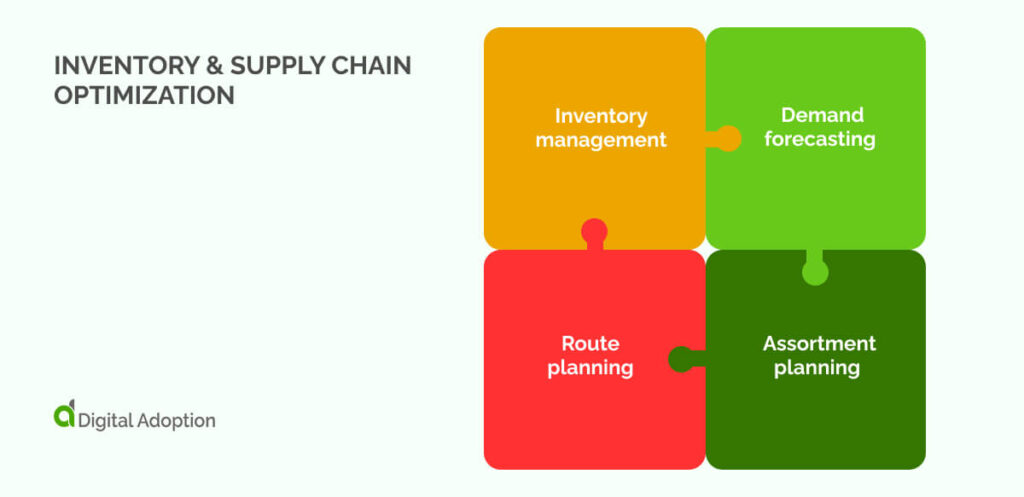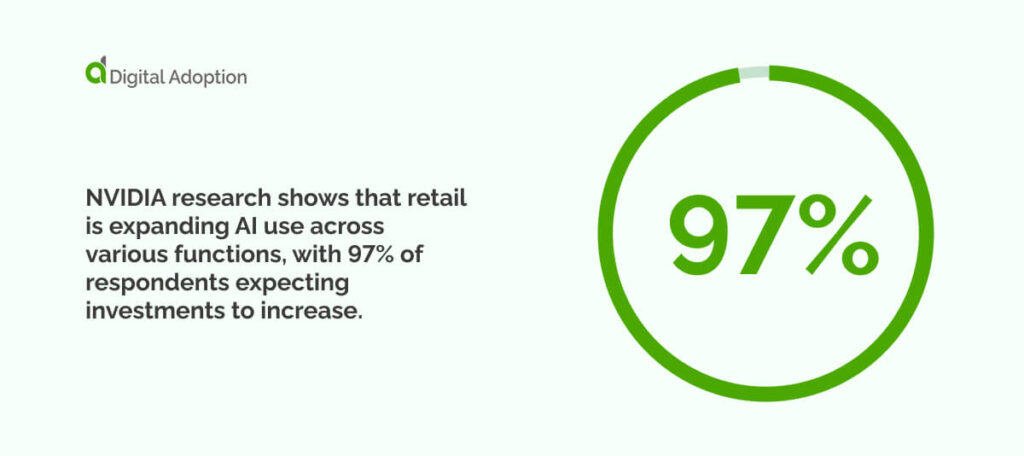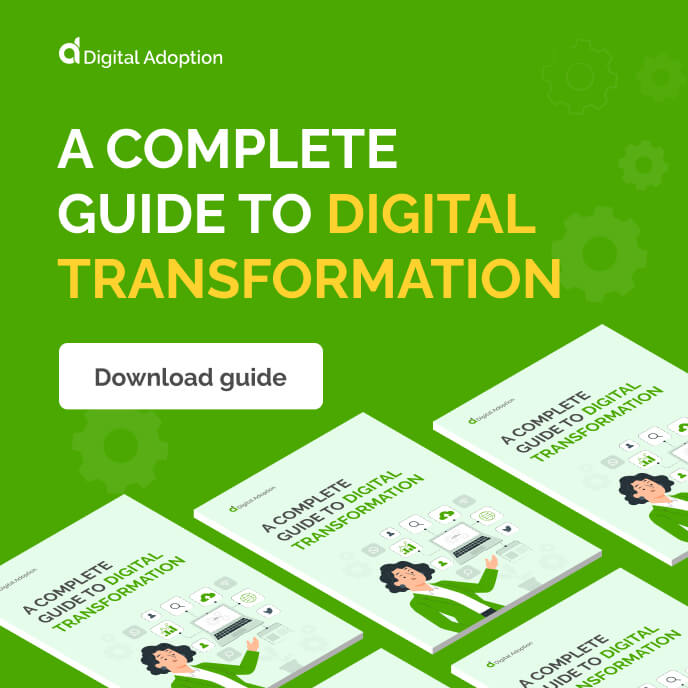AI adoption is accelerating across industries, with its numerous potential applications fueling business transformations in healthcare, finance, software development, and other sectors.
AI business models are trained on large amounts of data, enabling them to perform intricate actions, recognize patterns, and make decisions based on logical reasoning. These capabilities have not gone amiss in the retail sector, where AI is readily adopted to bring traditional retail processes up to speed.
We’ve compiled fifteen examples of AI in retail that showcase the different retail segments receiving an upgrade.
AI in retail examples at a glance:
| AI Technology | Function | Category |
| Inventory management | Tracks stock and restocks automatically when items run low. | Inventory & supply chain optimization |
| Demand forecasting | Predicts how much of each product will sell in each store. | Inventory & supply chain optimization |
| Route planning | Picks the fastest delivery routes based on traffic and delivery times. | Inventory & supply chain optimization |
| Assortment planning | Chooses which products to stock based on what sells best in each location. | Inventory & supply chain optimization |
| Personalized product recommendations | Suggests products based on what the customer has viewed or bought. | Customer experience & personalization |
| Virtual shopping assistants and AI agents | Chats with customers, answers questions, and finds products they might like. | Customer experience & personalization |
| Retail robots | Move through stores to check shelves and help with restocking. | Customer experience & personalization |
| Conversational marketing | Sends messages or chats that respond to how customers act or what they ask. | Customer experience & personalization |
| SMART stores | Utilize cameras and sensors to monitor activity and trigger automated actions, such as sending alerts or restocking. | Customer experience & personalization |
| Trend prediction | Spot new product trends from search, social media, and shopping behavior. | Marketing & merchandising intelligence |
| AI ad campaigns | Picks the best ads to show based on who’s watching and what gets clicks. | Marketing & merchandising intelligence |
| Content classification | Sorts product photos and descriptions into the right categories. | Marketing & merchandising intelligence |
| Price optimization | Changes prices based on demand, stock, and what others are charging. | Marketing & merchandising intelligence |
| Predicting business outcomes | Estimates how sales or profit will change after a business move. | Business strategy & predictive insights |
| Research & development (R&D) | Utilizes feedback and product usage data to refine or test new ideas. | Business strategy & predictive insights |
Inventory & supply chain optimization

Inventory has always been a balancing act; too much eats into margins, and too little loses sales.
With AI, retailers are starting to rethink how forecasting, logistics, and stock decisions get made, treating supply chains less like fixed systems and more like living, adaptable networks.
Inventory management
Ensuring supply chain transformations are fault-free and inventories are balanced is central in retail. Stores, vendors, and suppliers collaborate to maintain a steady supply of goods and meet demand.
Forecasting demand was once a manual process, relying on checks, paperwork, and approval chains. Human employees managed inventory and supply chains, but AI now offers autonomous solutions.
AI robots patrol factory floors and stockrooms with computer vision (CV) and data cameras to track real-time inventory. Every touchpoint, from production to shipping, waste to stock levels, is monitored in real-time to keep goods moving uninterrupted across the supply chain.
Demand forecasting
Predicting demand meant cross-referencing sales figures with inventory levels and production output. It had to observe cultural shifts for new products and services, deploying them within a relevant timeframe.
Demand forecasting often struggles to keep pace with shifting consumer expectations and market trends, requiring fast responses.
AI models can learn from historical sales data, observe niche markets and consumer shifts in real time, and predict demand trajectories. This helps balance inventory levels, avoiding overstocking, understocking, and waste.
AI forecasting enhances productivity for human workers, reduces overhead, and maintains operational agility.

Route planning
Route planning is one of the many components that keep retail supply chains moving. Consumer demands and buying behaviors evolve daily, and businesses must stay attuned to meet shifting expectations and introduce new products to shelves.
To support this, transport logistics must run without interruption. Decades-long collaborations across supply chains have shaped today’s route planning systems, now refined through the use of AI.
AI can aggregate large data sets to formulate an optimized strategy, accounting for sales trends, fuel costs, navigation routes, vehicle types, insurance, packaging, and wages. It absorbs real-time factors like traffic delays, weather, and roadworks, recalculates routes, and updates drivers instantly.
Assortment planning
AI assortment planning in retail is making product flow more efficient. Customer sales data is abundant, and the more AI systems learn from it, the more refined their solutions become.
This leads to a new era of logistical assortment planning, where AI manages each stage of the assortment chain and maintains balance in real-time.
AI tracks customer trends to understand product demand, pinpointing where it’s strongest and estimating stock needs. Meeting demand becomes more targeted, with products being moved based on regional buying patterns, demographics, seasonality, and current sales trends.
AI adjusts stock levels based on customer segmentation, reflecting actual preferences at each location.
Customer experience (CX) & personalization
Personalization isn’t a feature anymore. It’s what customers have come to expect. AI provides retailers with new ways to understand people by analyzing what they buy and how they move, browse, and behave across various channels.
Personalized product recommendations
Digital transformation efforts today primarily focus on enhancing customer experiences (CX) and improving the delivery of products and services. Statista finds that 83% of contact centre staff say customers expect support at any time, day or night.
The availability and speed of modern digital tools mean customers now expect shopping to feel fluid and intuitive. Traditional product recommendations relied on static sales stats and broad trend segments, offering loose guesses at what shoppers might want.
AI has changed this. It draws from past sales, personal behavior, spending habits, and even aesthetic cues, such as design, style, or color. Rather than relying solely on third-party data, AI creates profiles that accurately reflect each customer’s actual tastes and preferences.
Virtual shopping assistants and AI agents
Retail assistants and sales reps face growing pressures to deliver top-tier customer experiences around the clock.
Customers expect quick responses, product recommendations, and conversational support. Representatives must also handle payments, returns, refunds, and inventory management.
AI will help upend traditional customer experience (CX), assisting with many of these tasks. Many retailers are already deploying AI-driven virtual shopping agents with success. Juniper Research predicts global retail spending via chatbots will reach $12 billion in 2023, rising to $72 billion by 2028.
AI agents meet diverse customer needs 24/7, using data from sales history, preferences, demographics, and trends to provide personalized, targeted responses.
Retail robots
AI takes physical form in retail robots, expanding customer service capabilities across retail environments.
They are found in both customer-facing SMART stores and back-office spaces, where they act as warehouse assistants. In warehouses, AI-driven robots manage routine tasks like inventory checks, picking, sorting, and packaging.
In-store, these machines assist shoppers with product information, guide them to specific aisles, alert them to empty shelves, and send real-time stock updates to backend systems. They can speak multiple languages to serve a global customer base and may soon recognize returning customers, recalling past purchases and preferences.
As hardware and software continue to evolve, retail robots will increasingly handle customer-facing and operational roles more accurately.
Conversational marketing
Conversational marketing in retail uses AI to create real-time, context-aware dialogue between brands and customers.
It replaces static menus with natural interactions, answering questions, making suggestions, and adjusting tone based on behavior and history. These systems recognize intent, recall preferences, and react instantly.
Relevance in the moment is key. The days of pushing offers are behind us. The strength lies in subtlety, knowing when to communicate and when to be quiet. Personalization should be part of the interaction, not an added layer, making customers feel understood rather than sold to.
SMART stores
SMART stores use AI to make shopping more personal and efficient. Sensors and cameras track what shoppers look at, how long they stay, and what they pick up, allowing stores to respond instantly.
Digital signs and product suggestions are tailored to nearby items, past shopping habits, or the time of day.
Most SMART stores also have automatic checkout, where items are scanned digitally by product recognition software, and you’re billed after leaving.
The experience feels natural as the store learns from you without being invasive. Personalization is subtle yet built into the store’s operations, making each visit more informed for each shopper.
Marketing & merchandising intelligence
Marketing teams are moving beyond generic campaigns and static product displays.
With advanced product analytics and machine learning, they’re testing content in real time, optimizing pricing dynamically, and using in-store and digital behavior patterns to guide messaging and merchandising choices down to the stock-keeping unit (SKU) level.
Trend prediction
Trend prediction in retail once relied on seasonal cycles, historical sales data, and intuition. AI shifts this model by scanning vast datasets, social media chatter, search trends, and regional buying behaviors to surface emerging interests before they become widely known.
These customer insights provide retailers with a head start on what to stock, how to market it, and when to take action. It’s not just about spotting what’s hot, but understanding why it’s gaining traction.
With this foresight, merchandising strategies become sharper, launch timings more precise, and shelf space smarter. At the same time, AI helps retailers stay relevant in fast-moving markets where trend cycles last weeks, not seasons.
AI ad campaigns
AI is changing how retail ad campaigns are planned, tested, and scaled. Instead of building static campaigns based on broad demographics, retailers can now use AI to target audiences with real-time data, interests, behaviors, and intent.
Machine learning models automatically optimize ad creative, placement, and timing, adjusting spend where performance is strongest. Every campaign can adapt on the fly, improving reach and return.
The system also identifies which visuals, headlines, or formats resonate with each audience segment. When retailers do this, they learn with each impression. The result is sharper messaging, better conversions, and a more efficient use of marketing budgets.
Content classification
Content classification enables businesses to sort and organize digital content, including product listings, reviews, and advertisements.
AI can automatically label and categorize content by theme, making it easier to find and utilize. This enables retailers to display customers with more relevant information, such as products or ads that align with their interests.
With AI handling the sorting, companies can manage large amounts of content without it becoming overwhelming. This helps them improve and specialize their marketing efforts, keeping things organized for customers and making it easier to share the right information at the right time.
Price optimization
AI-driven price optimization is already changing how stores set their prices. Instead of sticking to a single, definitive price, AI considers the number of people buying a product, the prices charged by competitors, and the interests of customers.
It can adjust prices in real-time, raising them when demand is high or lowering them to increase sales. This means prices are always the best possible fit for the moment, not just based on guesswork.
It’s also better for savvy consumers who purchase products based on price fluctuations. Retailers can respond quickly to changes, making smarter decisions that help them sustain margins and keep customers content with optimal pricing.
Business strategy & predictive insights
Retail businesses are constantly navigating a world of change, where predicting trends and consumer behavior can make or break success.
Strategic decisions are no longer based on guesswork, but on the ability to read the signals of a shifting market, providing insights that help companies stay ahead of the curve.
Predicting business outcomes
Retailers are now looking beyond traditional forecasting methods to gain a deeper understanding of the future market.
This means predicting business outcomes through data transformation and analytics, which enables them to identify potential shifts before they occur. Anticipating trends is key, as is spotting new consumer behaviors or market gaps early on.
With these insights, retailers can pivot in real-time, recalibrate their strategies, and unlock doors to previously untapped opportunities. This shift leverages the power of proactive decision-making, shaping the future rather than merely reacting to it.
The result is more strategic, nimble retail frameworks, better positioned to thrive in a changing world.
Research & development (R&D)
AI in research and development rounds out our list of how this technology impacts the retail sector. Guesswork, legacy data, and bias have long limited R&D in the retail industry. AI removes this stagnation by using pattern recognition at a scale humans can’t match.
It allows retail teams to test hunches against simulations, not spreadsheets. AI models trained on seasonality, mood shifts, and trends, such as those on TikTok, now enable tailored retail messaging that once required significant investment.
The true shift is that AI enables R&D to move from a reactive to an innovative stance, putting retailers ahead of trends instead of chasing them.
A future look at AI in retail
Retail has taken a hit in recent years, with many businesses still recovering from the mass closure of physical stores and the shift to digital, where online shopping is the default.
Even now, some retailers struggle to remain profitable solely through digital channels and are exploring new ways to stay competitive, whether by reevaluating their warehouse operations or transforming their supply chains.
However, there is a window of opportunity for forward-thinking brands. AI is transforming the way products are sold, shipped, and experienced. According to American Military University, personalized shopping experiences are becoming the norm in retail, primarily due to advancements in AI-related retail technology.
Many retailers now utilize AI-powered recommendation engines, AI chatbots for customer service, and AI assistants to deliver tailored product recommendations and offer personalized customer support throughout the customer onboarding journey.
Investing early, experimenting boldly, and building AI into the DNA of your operations could be what sets you apart in a market where AI is quickly becoming the standard, not the exception.
People Also Ask
-
Can AI pricing tools adapt to competitor changes in real time?Yes. AI pricing tools track competitor prices and updates as they happen. They can quickly change your prices based on demand, stock levels, or market shifts. This helps retailers stay competitive without needing to monitor prices or make manual adjustments constantly.
-
How does AI support retail R&D decisions?AI helps retailers spot what customers like and what’s missing. It uses shopping patterns, reviews, and sales data to guide new product ideas. This allows teams to focus on products that people want, instead of relying on guesses or trial and error.
-
What safeguards prevent bias in AI ad campaign targeting?To reduce bias, retailers review the data AI uses and establish rules to prevent unfair targeting. They also test AI results to make sure no group is treated unfairly. Human teams often double-check the system to catch mistakes and improve fairness in ad delivery.

 FACT CHECKED
FACT CHECKED![15 Examples of AI in Retail [2025]](https://www.digital-adoption.com/wp-content/uploads/2025/06/15-Examples-of-AI-in-Retail-2025.jpg)







